OTC First Aid Medications: Antiseptics, Antibiotic Ointments, and Pain Relief Explained
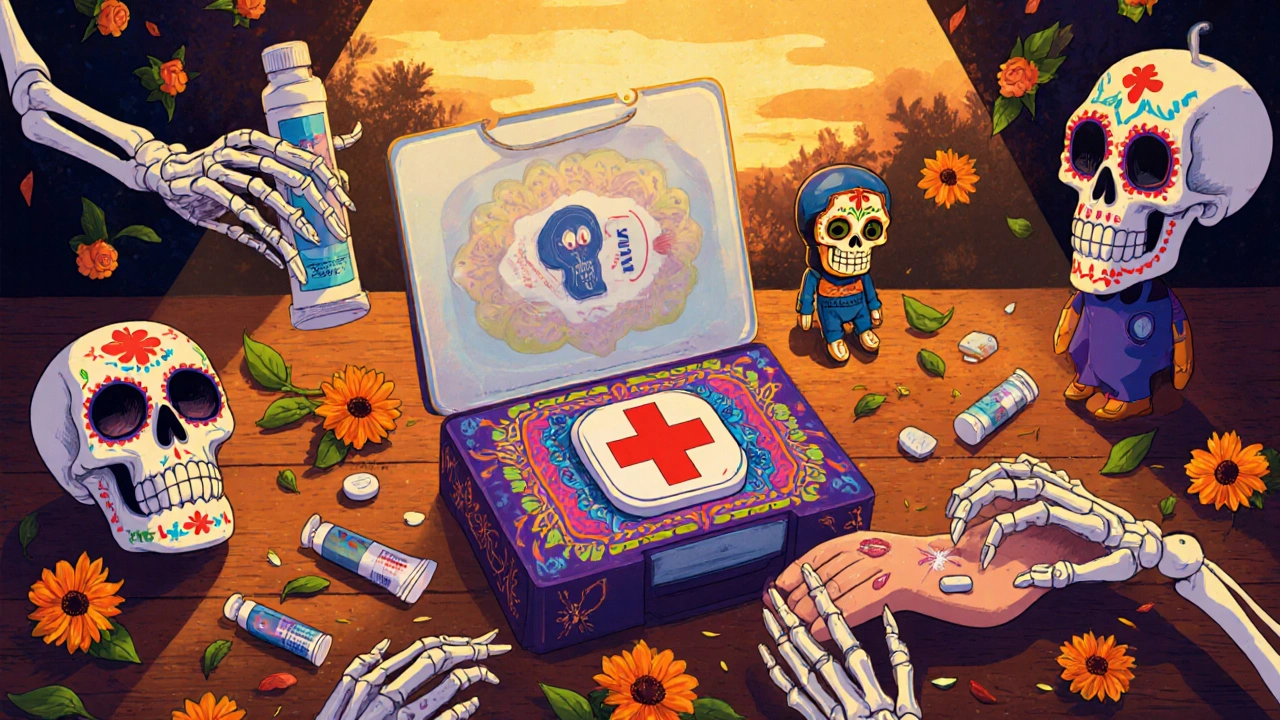
What You Need in Your First Aid Kit
Most people think a first aid kit is just bandages and gauze. But the real lifesavers? The OTC first aid medications you keep right beside them. Antiseptics, antibiotic ointments, and pain relievers aren’t optional extras-they’re the core tools that stop small injuries from turning into big problems. If you’ve ever had a cut get infected, a burn that burned for days, or a headache that knocked you out for hours, you know how much these three things matter.
Antiseptics: Clean the Wound, Not the Open Cut
Antiseptics are your first line of defense. They kill germs on the skin around a wound. But here’s the thing most people get wrong: you don’t pour hydrogen peroxide or rubbing alcohol directly into an open cut. Doing that doesn’t help-it hurts. It kills healthy tissue, slows healing, and can even make the wound worse.
Use antiseptics on the skin around the injury, not inside it. A 3% hydrogen peroxide solution or 70% isopropyl alcohol wipes work well for cleaning the area before you apply anything else. Povidone-iodine (like Betadine) is another solid option-it’s stronger, kills more types of germs, and is less likely to irritate skin. But it stains everything brown, so keep it away from clothes.
Here’s what you need to know about shelf life: hydrogen peroxide goes bad fast. Once you open the bottle, it starts losing power. After 30 days, it’s barely doing anything. Alcohol wipes stay good longer if sealed, but once opened, they dry out. Always check the expiration date. An expired antiseptic isn’t just useless-it’s a false sense of security.
Antibiotic Ointments: Prevent Infection, Not Cure It
After you clean the wound, you want to keep bacteria out. That’s where antibiotic ointments come in. The most common ones-like Neosporin-contain three antibiotics: bacitracin, neomycin, and polymyxin B. Together, they cover a wide range of bacteria that cause infections in scrapes, cuts, and minor burns.
Studies show these triple-antibiotic ointments prevent infection in over 90% of minor wounds when used correctly. But here’s the catch: you need to use them right. Clean and dry the area first. Then apply a thin layer-not a glob. Cover with a bandage if needed. Don’t leave it exposed; dirt and bacteria will get in.
But not everyone can use Neosporin. About 5% of people are allergic to neomycin, one of its ingredients. Signs? Redness, itching, swelling that gets worse after a day or two. If that happens, stop using it. Switch to a bacitracin-only ointment. It’s just as effective for most cases and doesn’t carry the same allergy risk.
And don’t keep that tube forever. Once opened, antibiotic ointments lose about 15% of their strength each year. Even if it still looks fine, replace it every 12 months. Old ointment won’t kill germs. And using ineffective ointment is worse than using nothing at all.
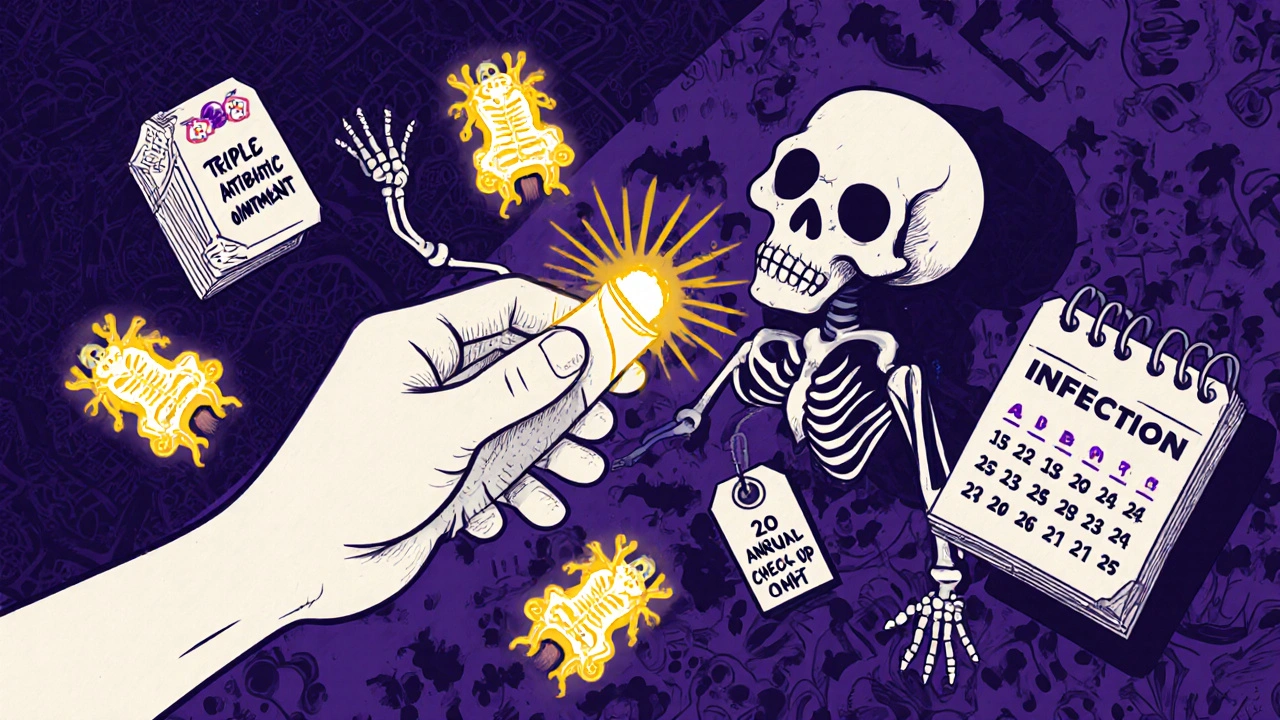
Pain Relief: Know Which One to Pick
Not all pain relievers are the same. The four main OTC options are acetaminophen, ibuprofen, aspirin, and naproxen. Each works differently. Picking the wrong one can mean no relief-or worse, side effects.
Acetaminophen (Tylenol) is your go-to for headaches, fever, or minor aches without inflammation. It doesn’t reduce swelling, but it’s gentle on the stomach. If you have a sensitive gut or take blood thinners, this is usually the safest choice. But here’s the danger: too much can wreck your liver. Never take more than 3,000mg a day, and absolutely avoid alcohol while using it. The FDA warns that accidental overdoses are the #1 cause of liver failure from OTC meds.
Ibuprofen (Advil, Motrin) is an NSAID. It fights inflammation, so it’s better for sprains, muscle pain, or anything swollen. It also knocks out fever fast. But it can irritate your stomach. About 1 in 80 regular users gets ulcers or bleeding. Take it with food. Don’t use it for more than 10 days straight without seeing a doctor.
Aspirin is older, but still useful. It works for pain and fever, but its real superpower? Heart attacks. If someone shows signs of a heart attack-chest pain, shortness of breath, nausea-chewing one 325mg aspirin can cut death risk by 30%. But don’t give it to kids or teens. It can cause Reye’s syndrome, a rare but deadly condition.
Naproxen (Aleve) lasts longer-up to 12 hours-so it’s good for all-day pain. But it’s harder on your heart and kidneys. Avoid it if you have high blood pressure, heart disease, or kidney problems. It’s not the first pick for most people.
Here’s a simple rule: use acetaminophen for non-inflammatory pain (headaches, toothaches). Use ibuprofen for anything swollen or sore (sprains, period cramps, post-workout pain). Keep both in your kit.
Storage and Safety: Don’t Let Your Kit Go Bad
Storing these meds wrong is like having no meds at all. Heat and moisture are killers. Keep your first aid kit in a cool, dry place-like a bedroom drawer, not the bathroom or the glovebox of your car. Temperatures above 86°F (30°C) for more than two weeks can cut acetaminophen’s effectiveness by 35%.
Check your kit twice a year. When you change your smoke detector batteries, check your meds. Most households have at least one expired pill or ointment. Expired pain relievers might still work, but they’re weaker. Antibiotic ointments and antiseptics? Don’t risk it. Toss them.
Always read the Drug Facts label. It’s not just a formality. It tells you the dose, how often to take it, warnings, and what to avoid. Most OTC mistakes happen because people guess. “I took one last time, so I’ll take two now.” That’s how you end up in the ER.
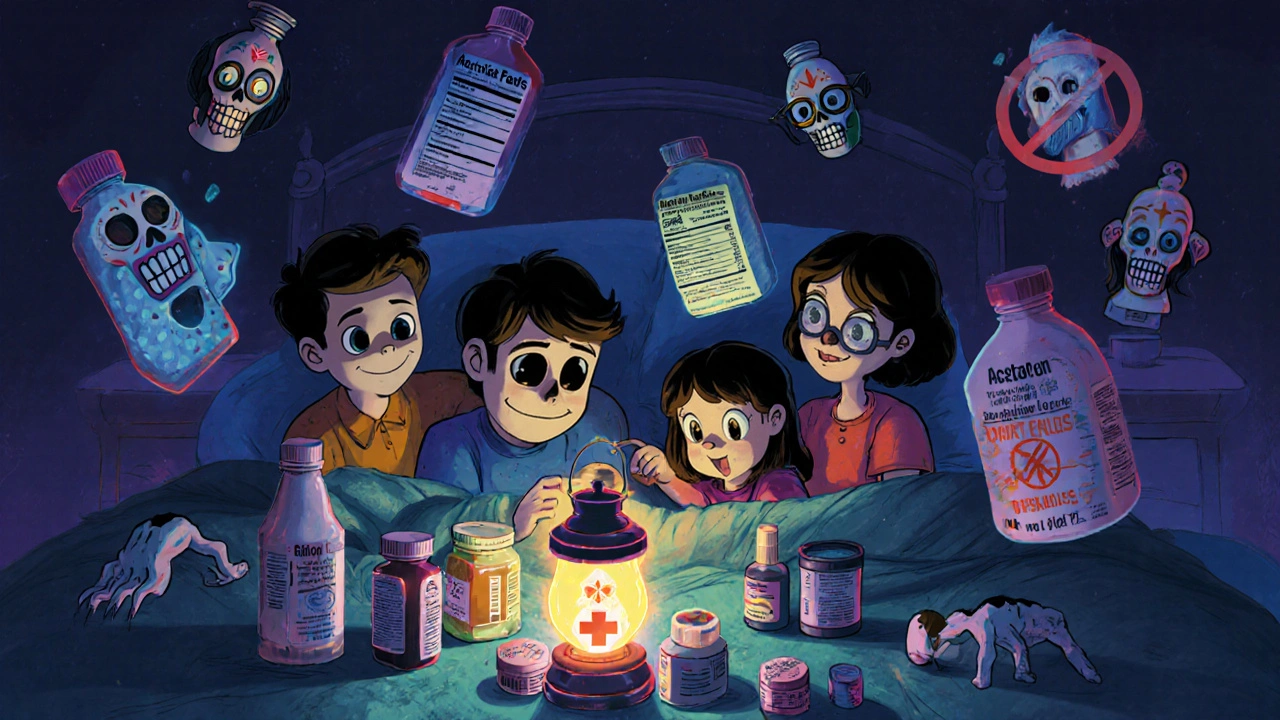
Real-Life Use: What Works and What Doesn’t
People on Reddit’s r/FirstAid tell stories that prove these rules matter. One guy kept a small kit in his work bag. When he cut his finger on a metal edge during a business trip, he cleaned it with alcohol, put on bacitracin, and covered it. No infection. No missed work.
Another person used hydrogen peroxide directly on a deep cut. Ten days later, the wound was still open and painful. He finally saw a doctor. The delay cost him two weeks of recovery.
These aren’t rare cases. They’re everyday mistakes. And they’re preventable.
What to Keep in Your Kit
Here’s a simple list for a basic home first aid kit:
- 3% hydrogen peroxide or 70% isopropyl alcohol wipes
- Povidone-iodine solution (for sensitive skin or stubborn dirt)
- Triple antibiotic ointment (or bacitracin-only if you’re allergic)
- Acetaminophen (325mg or 500mg tablets)
- Ibuprofen (200mg tablets)
- Aspirin (81mg or 325mg tablets-keep a few for emergencies)
- Calibrated measuring spoon or oral syringe (never use kitchen spoons)
- Bandages, gauze, medical tape
Store it where everyone in the house can reach it. And make sure kids know it’s not candy.
When to Call a Doctor
These meds are for minor stuff. If you’re still in pain after 7 days, if the wound looks red, swollen, or oozing, or if you’re dizzy, nauseous, or have trouble breathing after taking a pill-stop. Call a doctor. OTC meds aren’t a substitute for professional care. They’re a bridge. Use them to get through the first few hours or days. Not to avoid seeing someone when you need to.
Can I use hydrogen peroxide on an open wound?
No. Hydrogen peroxide damages healthy tissue and slows healing. Use it only on the skin around the wound, not inside it. Clean the wound gently with water or saline, then apply an antiseptic to the surrounding area.
Is Neosporin the best antibiotic ointment?
It’s one of the most effective for most people, but not for everyone. About 5% of users are allergic to neomycin, one of its ingredients. If you get itching or redness after using it, switch to a bacitracin-only ointment. It works just as well for preventing infection without the allergy risk.
Which pain reliever is safest for daily use?
None of them are meant for daily use. If you need pain relief every day, see a doctor. Acetaminophen is gentler on the stomach than ibuprofen, but too much can harm your liver. Ibuprofen can cause stomach bleeding. Long-term use of any OTC painkiller masks underlying problems and can lead to serious side effects.
How often should I replace my first aid medications?
Replace antibiotic ointments every 12 months after opening. Antiseptics like hydrogen peroxide lose effectiveness after 30 days. Pain relievers in tablet form can last 2-3 years past expiration, but their potency drops. Liquid forms degrade faster. Check expiration dates twice a year and toss anything old.
Can I keep my first aid kit in the car?
Not if it gets hot. Temperatures above 86°F (30°C) for more than a few days can ruin acetaminophen and reduce the strength of other meds. Keep your kit in a cool, dry place like a bedroom drawer. If you must keep one in the car, choose a shaded, insulated container and check it often.

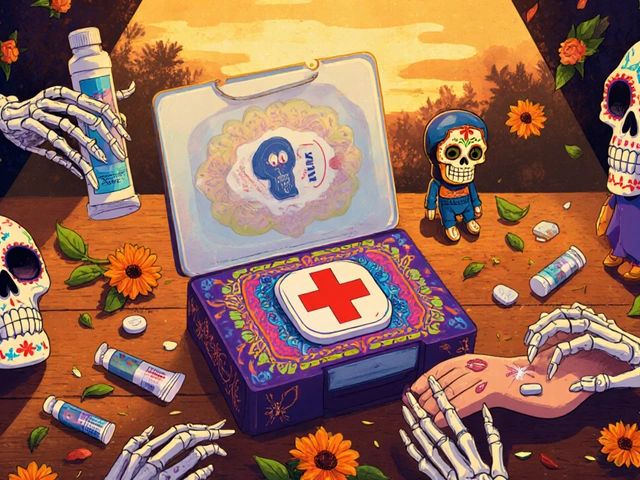
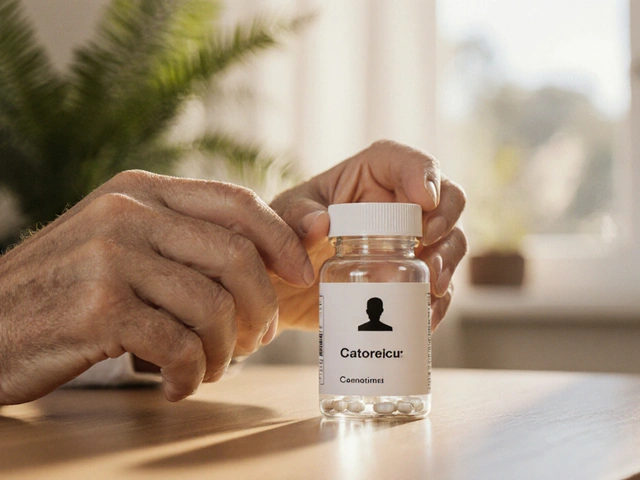



I grew up in a household where the first aid kit was kept in the kitchen cabinet next to the spices-bad idea. Heat and moisture killed everything before it was even needed. I learned the hard way after my cousin got a burn and we used an old tube of Neosporin that had turned into glue. Now I keep mine in a sealed plastic box in the bedroom drawer. Life-changing shift.
Hydrogen peroxide on open wounds is a myth. Don't do it.
I used to use Neosporin on everything until I broke out in a rash after a small cut. Switched to bacitracin-only and no more issues. Also learned the hard way that if it's been open longer than a year it's basically a paperweight. Always check the date
You people still use hydrogen peroxide? Bro. It's not 1998. Saline rinse then antibiotic ointment. Done. Stop killing your own tissue. I've seen more infections from people trying to 'disinfect' with peroxide than from actual dirty cuts.
I'm so glad someone finally said this. 🙌 I work in urgent care and 30% of the patients who come in with infected minor wounds had been using peroxide or alcohol directly on the cut. It's not cleaning it-it's torturing it. Also, if your ibuprofen bottle is older than your phone, toss it. 💊🔥
I must respectfully point out that while the advice regarding antiseptics and ointments is sound, the cultural context of first aid storage varies significantly. In many households across South Asia and parts of rural America, the kit is kept in the kitchen or near the bathroom for convenience. While this may compromise efficacy, it also ensures accessibility. Perhaps a compromise-sealed, insulated containers in high-traffic areas-might be more practical than insisting on the 'ideal' storage location.
As someone who grew up in a family of nurses, I’ve seen the damage done by outdated meds. But I’ve also seen how people in low-income homes can’t just toss things out. Maybe we need more community programs that offer free medication exchanges? Not everyone can afford to replace their kit every year.
You know, it’s fascinating how deeply ingrained these misconceptions are-like the idea that 'cleaning a wound with peroxide' is somehow a rite of passage, like learning to ride a bike or tying your shoes. We inherit these habits from our parents, our neighbors, our TV shows, and we never question them until we get burned-literally. And yet, the science is so clear: healthy tissue regeneration requires a gentle environment, not chemical warfare. It’s not just about what we use, it’s about what we believe we’re doing when we use it. We think we’re being proactive, but we’re often just reinforcing a cycle of harm. Maybe the real first aid kit isn’t the one in the drawer-it’s the one in our minds. The willingness to unlearn, to pause, to check, to ask. That’s the real life-saving tool.
I always keep a small first aid kit in my purse, especially since I work with kids, and I’ve learned that even the smallest cut can turn into a big deal if not handled right. I use saline wipes for cleaning now, and I’ve switched to bacitracin because my daughter had a reaction to Neosporin. Also, I label everything with the date I opened it-because I forget, and I don’t want to be that person who uses expired stuff.
The key is consistency and education. Not just having the right supplies but knowing how to use them. I’ve trained volunteers in rural communities, and the most common mistake isn’t lack of supplies-it’s lack of understanding. We need more public health messaging that’s simple, visual, and repeated. Not just a blog post. Real campaigns.
Just replaced my whole kit this morning 🙌 I threw out 3 expired ointments, 2 bottles of peroxide (they were like water 😅), and my ibuprofen that was from 2020. I’m now using a small waterproof container in my closet. Also bought a little calendar sticker to mark when I open things. Small habits, big difference 💪❤️